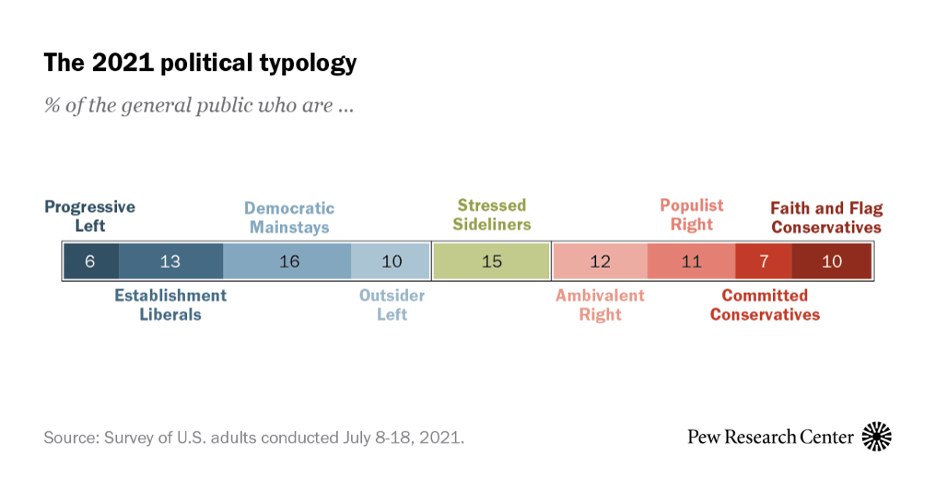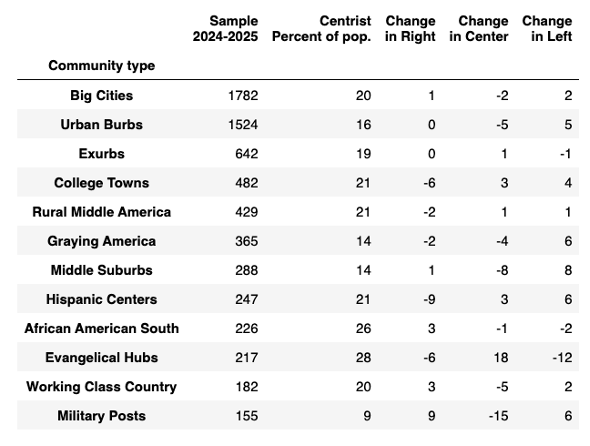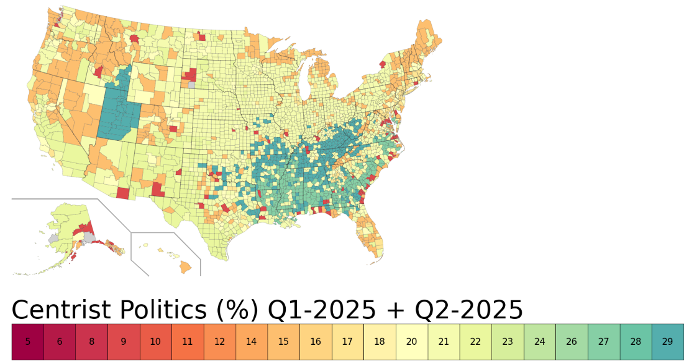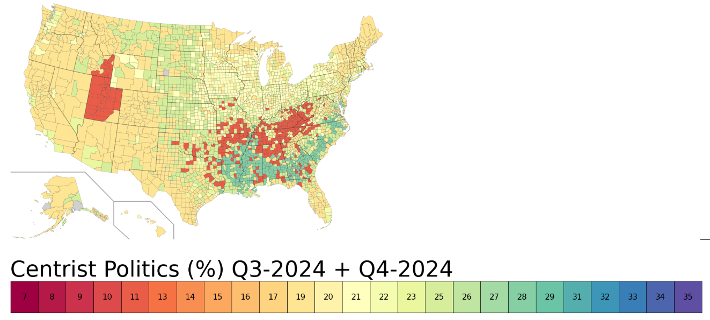The Political Centrists in American Communities
GivingTuesday Data Commons has been running a weekly national survey on generosity and identity in the U.S. for the past three years. We reported on what we learned about the Populist Right in July and the Left in August. Now we follow up with insights about centrist groups.
We use an eight-part question about one’s worldview to place people on the U.S. political spectrum, adapted from a Pew Research survey. Combining this with ACP’s model tells us how the current political landscape plays out in various community types.

Centrists, according to Pew’s Political Typology, are a mix of the Ambivalent Right, the Outsider Left, and Stressed Sideliners.
What Centrists Believe, According to Pew Research
- 80% of Centrists do not follow government and public affairs most of the time. Growing up, few of them heard this discussed at home.
- 63-76% of Centrists don’t see a great deal of difference between the two major political parties.
- 68-91% of Centrists agree that America’s openness to people from all over the world is essential to who we are as a nation. This is one of the few policy positions that all three centrist groups share, and they align with the Left on this. Few Centrists support stronger border security.
How Centrists’ Values Compare With Those on the Left and the Right
These trends are from our GivingPulse generosity survey, based on a sample from the last 15 months:
- They are slightly less likely to have participated in an act of generosity. They are also less likely to report being asked to participate through solicitation.
- They are less likely to report trusting other people.
- They are most likely to feel “ambiguous” about their sense of community belonging, rather than having a strong sense of belonging or non-belonging.
- When asked what their most important act of generosity was, they are most likely to value giving items, and less likely to value volunteering.
- They appear to be less “plugged in” to community or national issues. Within the larger umbrella of Centrists, Stressed Sideliners are defined by their lack of time to engage, due to economic stress.
Where are they found? Centrists are evenly spread across all community types (typically around 16-21% of the population), but more prevalent in the African American South (26%) and least prevalent in Military Posts.
Political Shifts in 2025 toward centrism
In the first half of 2025, we saw a shift in some of the most conservative parts of America toward centrist beliefs. This combines both a shift in the center-left toward centrist ideas and a shift from the Populist Right toward the center.

(Footnote on our tables and maps: We recoded LDS Enclaves as Evangelical Hubs, Aging Farmlands as Working Class Country, and Native American Lands as Hispanic Centers due to limited sample size, as those were the closest county types. All remaining groups had at least 150 respondents. County types are ordered by largest to smallest sample size.)
The table shows the change in the percent of each respective community type that align with the Right, Center, or Left between 2024 and 2025. The percent of population in the table comes from our 2025 sample.
Note how Centrists were least prevalent in these areas in 2024:
People in Hispanic Centers and Military Posts
In the first half of 2025, people in Hispanic Centers have shifted politically. Hispanic Centers are filled with younger residents with lower incomes. These areas, concentrated in the Southwest and Florida, appeared to be Populist Right strongholds in the second half of 2024. Since then, they have appeared to shift toward a mix of less conservative beliefs in 2025. Overall, 1 in 3 respondents in these areas appeared to have Populist Right beliefs in 2024; now 1 in 5 appear to have them in 2025. It is important to note that Hispanic Centers have only a slim majority (53%) of people who identify as Hispanic on average. The counties are where immigration is a hot-button issue, according to the American Communities Project. They narrowly voted for Democrats in every national election since 2008 but shifted toward Trump in 2024.
Hispanic Centers
Military Posts — young, diverse, middle-income communities around military bases — differ in that they were dominated by the Populist Right in 2024 and have since moved toward traditional “Committed Conservative” ideas in 2025. Also, about 1 in 4 identified as Centrist here in 2024, but now only 1 in 12 are in 2025.
Military Posts
How fluid are political identities?
The political center (around 37% of the population) is defined by some combination of disliking both political parties and feeling too busy/stressed to engage, but they’re not always the same people, year after year. Pew Research finds that people drift in the way they think about issues and how what they believe shapes their identity. They report that 9% of Republicans or Democrats switched to the opposite party between 2018 and 2020 (based on a sample of 11,077 voters), more than the typical margin in national elections. Based on our data, we also find that changing beliefs or growing doubts around a single belief could reassign a person to a different group. In particular:
- If Establishment Liberals lost faith in the government as the answer, and began to see religion as a valuable partner, about 70% of Establishment Liberals would become Democratic Mainstays.
- Members of the Outsider Left feel a disconnect with the Democratic party. If they trusted it more, they would align with the Progressive Left.
- About 30% of the Ambivalent Right would realign with Stressed Sideliners if they were to start believing that the economic system unfairly favored powerful interests over regular people.
In the first half of 2025, we began to see the Populist Right and Ambivalent Right align on immigration. Previously they split over their openness to people from around the world, but now the Populist Right is more open to the world (shifting from 23% support for openness in 2021 — according to Pew — to about 50% support in 2025), while the Ambivalent Right is becoming less open (75% support dropped to 66% in 2025).
Conclusions
In our sample of 6,700 people over the last 15 months, we see early signs that groups on the right are adopting more centrist views in early 2025. Further research may uncover key drivers of these shifts.
 Marc Maxmeister, Senior Data Scientist at GivingTuesday, helps organize and convert the world’s generosity data into meaningful insights into how giving works, and what organizations can do to improve the lives of people served. He brings context from mixed methods field research in Africa, rigor from his Ph.D. work as a molecular neuroscientist, and engineering from past AI-driven startups and nonprofits.
Marc Maxmeister, Senior Data Scientist at GivingTuesday, helps organize and convert the world’s generosity data into meaningful insights into how giving works, and what organizations can do to improve the lives of people served. He brings context from mixed methods field research in Africa, rigor from his Ph.D. work as a molecular neuroscientist, and engineering from past AI-driven startups and nonprofits.


